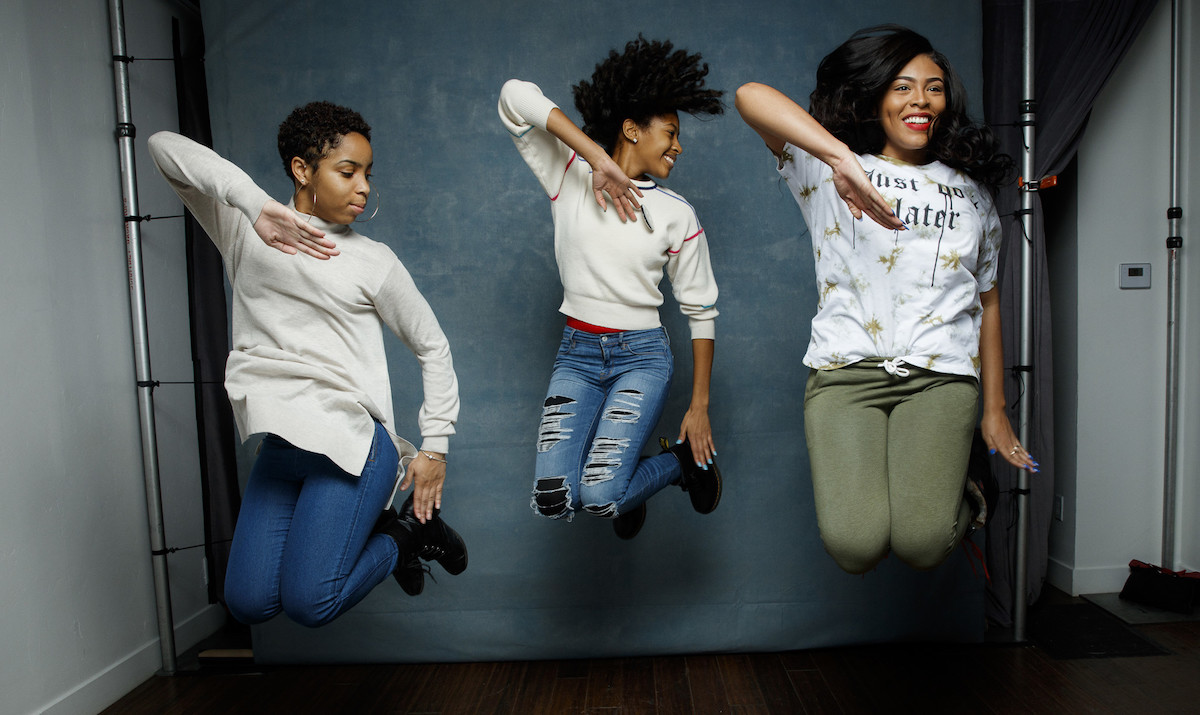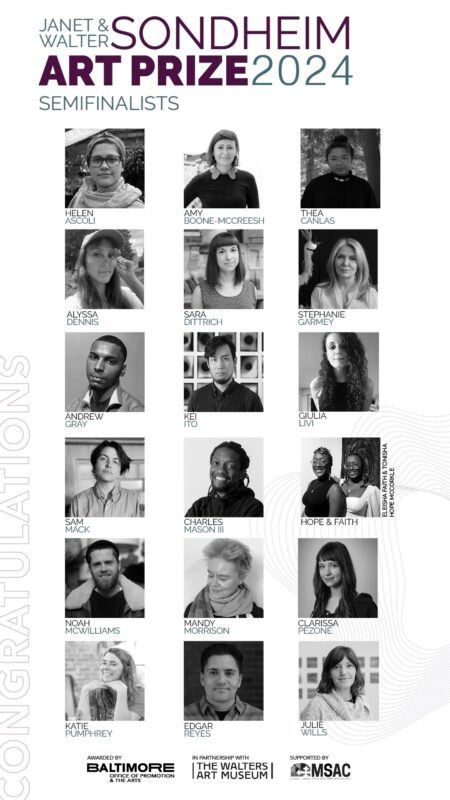Inside a Wing of a Former Sail Cloth Factory in Baltimore’s Woodberry Neighborhood, Two Sisters Merge Craft and Industry by Rachel Bone
Like any solid success story, Biggs and Featherbelle soap company started in a family garage (ok, technically it was a basement, but, details).
Fifteen years ago, Kelly Evick (now Parker) and Kacey Evick, two sisters from Baltimore, found themselves moving back in with their parents after life threw them each temporarily off their feet. In a search for cheap Christmas gift ideas, they came across an article on soap making. Parker, interested in holistic body care after a lifetime of skin issues, became obsessed with the process, and after rave reviews of their handmade gifts, Evick used her graphic design background to create a website and some iconic packaging. They researched essential oils, and concocted new fragrance mixes and enlisted family members to help. By the following year, a company was born and business at craft fairs was booming.

Fourteen years later, both sisters are still working exclusively with the natural and organic ingredients that built their first bars of soap. They are each happily married with children, and have long since outgrown that basement workshop and free family labor.
Biggs and Featherbelle takes up eight thousand square feet of warehouse space in Woodberry and employs twenty people, including a partnership with a non-profit to employ autistic adults, and a self-led program hiring former felons. (Both programs would earn the company tax breaks, but they have yet to claim on either). They’ve traded working the craft fair circuit for nurturing relationships with large grocery stores like Wegmans and Whole Foods, but have managed to maintain the integrity of their original mission even as they’ve grown.
What has changed most since 2002 is their own well being, and general outlook on life. What has stayed the same are the ingredients (only natural materials, and essential oils are used in their soaps, organic where possible), and a dream scenario in which two siblings — also hilarious and sarcastic best friends — are together all day long.
Evick: In 2002. We were both living at our parent’s house.
Parker: We’d go to Taco Bell on Friday nights. That was the state of our social life.
Evick: Well we had a lot of time on our hands, anyway. We were looking at a Martha Stewart magazine and saw an article on making soaps….
RB: And you were like, “Ok, all is lost. Let’s make soap?”
Parker: Pretty much! We’d had no money for Christmas gifts, so we made soap for everyone. When that went well, we figured we might as well start a business!

My grandmother had died in the basement just a few months before, and I was nervous she was haunting it. Before we started the business, I moved everything out of it, burned some sage, and then moved everything back in. (I told you I was crazy).
Evick: Our mom went to the library and found us a book on it. Kelly read the book and figured out the process itself. Our acupuncturist was the one to sign us up for a craft fair for the first time.
Parker: We’d always wanted to start a business together, so it felt like fate. We grew up in a health nut family. I was having health problems, and was going to an herbalist. Starting the business helped us both get healthy.

Evick: Stress can make your body do crazy things. I look back at photos of myself around the time of my divorce, and I was so unhealthy. Then we both started getting ourselves healthier. we lost weight, started doing yoga… came back to more healthy living. That’s when we started the business. We decided to join in on that movement with body care, and we wanted our soaps to be nutritious.
RB: So that was the most important aspect of the business from the beginning?
Evick: Yes. We wanted to create an affordable, natural product and maintain great quality. We want every single ingredient to be purposeful. We use only natural ingredients and essential oils.
There was a definite hole to be filled when we started. Health and body products are still not regulated in the same way food is, and that’s a shame. We want to be a healthy, honest company and use only natural, purposeful products.

RB: So as you’ve grown, you have moved away from doing craft shows, and your main customers are now wholesalers. Does selling to larger companies compromise what gets made, or what new products come out, or do you still get to decide?
Evick: We do have to cater to what their customers will buy, which means we have had to simplify, more than anything. No matter how many new combinations we come up with, people who tend toward natural body care also tend toward the basics. They want Lavender, and they want lemongrass. So we focus on the integrity, instead of the complexity.
With Wegmans, we do seasonal products, and come out with new things, which is fun and creative. This year we did a pumice foot scrub.

RB: Is it frustrating to you that people desperately want this hand made, artisanal thing, but they also want it to be recognizable and basic?
Parker: Oh for sure. We joke about that, but we have fun with the packaging instead, and we still make everything by hand, even if it is repeatative. We always want to go nuts with inventing new products, but what people often want is simple, and recognizable, and that’s ok. That’s admirable too. We have a lot of return customers, so I think people get into a routine, and they buy what works for them.
RB: Wholesale, Packaging, Employees, New Accounts… How much of this has been learning on the fly? Neither of you are from a business background, correct?
Parker: Nope. Everything! People will say “read this book, or that book…” There is no book. You learn as you go and make up your own rules. Every day it’s something new. It’s scary, but you get used to the craziness. We learn with every account, with every employee. Now we both have kids, and it’s even more complicated and chaotic!
Evick: We’ve been in business 15 years, and I still feel like we’re treading water. The second you feel under control, you grow, and have to learn how to manage a bigger company. More people are relying on us for their incomes. We have overhead. It’s not just the two of us anymore.


Parker: The other thing we just did, was hire a manager directly beneath us to keep things running. We also hired an outside HR department who helped set up an employee handbook, and payroll, and everything. In the beginning, [our employees] were just friends and family, but now we need to be less casual, and more consistent. It’s been an adjustment but I think largely most people appreciate the structure and clarity.
Four years into running the business, we took a class through a local non-profit called Women Entrepreneurs of Baltimore (WEB) that helped us write a business plan, etc. You had to be in a minority or low income to get into the program, and I’m pretty sure we only got in because I was having mental health issues. Whatever the case, we are eternally grateful to them.
RB: How much has family played a part? I know your parents were involved from the beginning?
Parker: From the beginning! My parents retired right before we started the business and the minute they retired, they started working for us. Mom did all the shipping, our aunt & uncle also came and worked, dad worked. We were in the basement 5 years, then we moved to the main building at Hooper mill, then got moved to a stand alone building 5 years later because the smell from the soaps was so strong it bothered other tenants.
RB: What’s new for you guys right now?
Evick: We just added Giant as a customer, we’ve set up displays in a few of their stores. It’s not as much about our natural aspect to them, more about our backstory. You know, “Two Sisters… blah blah blah” which is different than with MOMS (Organic Market), and Whole Foods, who wanted us for being both local and natural.

RB: With the larger companies, who decides how much, or what products the store will purchase? Are you the ones designing the display?
Evick: We all decide together, but we create an order based on how we design the display. Usually, we are then in charge of merchandising and maintaining that display. We go in every couple weeks, to every store. We can’t stretch ourselves between all the stores, so we are finally going to hire a merchandiser now.
Parker: We’re a smaller, unique setup, so most stores ask us to maintain the display. But you’ve actually hit on our big struggle right now. Large brands have thousands of dollars to customize their displays, but we don’t have the money to do that every time we go into a new store. We aren’t able to pay for fabricating new custom dimensions, so [we] are usually building them ourselves.
Evick: I do all the signage myself. At Giant, I got the backdrop printed and thought I’d saved so much time and money. Then we went into the test space, and found that the shelves were different than we had expected. So we had to spend a few days figuring out that problem.

RB: Wait… what is a test space?
Parker: A mockup store! In Pennsylvania, there is an entire, full size Giant mockup store, completely stocked with real product (vendors provide the product). You have to get buzzed in and everything. All the shelves are set up, and it just feels like you’re in a Giant after hours. It’s set up exactly like a real store, so that they can see how new displays and products will look. If any changes need to be made, it gets done there, rather than in the middle of a store that’s open for business.
RB: When a Giant or similar store approaches you, is it one individual location that contacts you, or the larger entity?
Evick: The larger entity. Giant was looking for an artisan company to add, and sought us out to put in the flagship store to see if we did well. Someone from their parent corporation (Ahold) saw us in Wegmans, and approached us. Wegmans found us in Wholefoods, and Wholefoods found us in a tiny shop called David’s which is local. We had approached David’s ourselves.
Before that, small independent stores like Trohv, in Hampden, found us at craft fairs and other shops have found us at Trohv.
RB: So they all just cherry pick off each other?
KP: (laughing) Yep, but it’s good for us, so we don’t mind. Everyone wants to find something small and local, which we are! Funny enough, the bigger we get, the less small and local we feel. That’s something we’ll always try to hold on to. You have to remember your roots.






